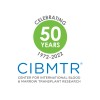A Phase II Study Evaluating the Safety and Efficacy of Subcutaneous Plerixafor
Related Donors Donating Peripheral Blood Stem Cells (PBSC) to a Family Member, Acute Myelogenous Leukemia, Acute Lymphoblastic Leukemia

About this trial
This is an interventional treatment trial for Related Donors Donating Peripheral Blood Stem Cells (PBSC) to a Family Member
Eligibility Criteria
Inclusion Criteria:
Donor:
- Donor eligibility will be determined according to applicable federal, state and local regulations and institutional standards
- 18-65 years of age
- 6/6 HLA-matched sibling
- Fulfill individual Transplant Center criteria to serve as a mobilized blood cell donor
- Serum creatinine <2.0mg/dl
Recipient:
- 18 to 65 years of age
- 6/6 HLA antigen matched sibling willing to donate PBSC for transplant
- Fulfill individual Transplant Center Criteria for transplant
One of the following diagnoses:
- Acute myelogenous leukemia (AML) in 1st remission or beyond with <5% marrow blasts and no circulating blasts. Marrow must be done within 30 days of the start of transplant conditioning regimen in alignment with other pre-transplant assessments.
- Acute lymphoblastic leukemia (ALL) in 1st remission or beyond with <5% marrow blasts and no circulating blasts
- Myelodysplastic syndrome, either intermediate-1,2, or high risk by International Prognostic Scoring System or transfusion dependent
- Chronic myelogenous leukemia (CML) failing or intolerant to tyrosine kinase inhibitor based therapy
- Non-Hodgkin's lymphoma (NHL) or Hodgkin's disease (HD) in 2nd or greater complete remission, partial remission, or in relapse (but with at least stable disease after most recent therapy)
- Chronic lymphocytic leukemia (CLL), relapsing after at least one prior regimen, or in remission with 17p deletion
- Serum creatinine must be <2.0mg/dl
- Total bilirubin and AST <3x normal
- Infectious disease marker (IDM) monitoring will be performed per institutional standards
- Karnofsky performance status of 70% or greater.
- Patients who have undergone a prior autologous transplantation are eligible for a reduced intensity transplant only
Exclusion Criteria:
Donor:
- Donor unwilling or unable to give informed consent, or unable to comply with the protocol including required follow-up and testing
- Donor already enrolled on another investigational agent study
- Pregnant or breast feeding females, or females not willing or able to use adequate contraception if sexually active
Recipient:
- Patient unwilling or unable to give informed consent, or unable to comply with the protocol including required follow-up and testing
- Patients with active, uncontrolled infection at the time of the transplant preparative regimen
- Pregnant or breast feeding females, or females not willing or able to use adequate contraception if sexually active
- Patients with a history of previous CNS tumor involvement showing active symptoms or signs along with documented disease on lumbar puncture and MRI of the brain within 30 days of start of conditioning
- A condition, which, in the opinion of the clinical investigator, would interfere with the evaluation of primary and secondary endpoints.
Sites / Locations
- H. Lee Moffitt Cancer Center
- Emory University
- University of Chicago
- Massachusetts General Hospital
- University of Minnesota
- Mayo Clinic
- Washington University
- Duke University
- Cleveland Clinic
- Ohio State University
- West Virginia University
- Medical College of Wisconsin
Arms of the Study
Arm 1
Arm 2
Arm 3
Experimental
No Intervention
No Intervention
Related donors receiving plerixafor
Recipients, myeloablative regimen
Recipients, reduced intensity conditioning regimen.
Collection of sufficient CD34+ cells using plerixafor as the mobilizing agent. Eligible donors determined according to institutional standards 18-65 years of age 6/6 HLA-matched sibling Fulfill individual Transplant Center criteria to serve as a mobilized blood cell donor Serum creatinine <1.5 x institution upper limit of normal (ULN) or estimated creatinine clearance (CLCR) >50 mL/min Treatment Description: Receive subcutaneous plerixafor at 240 μg/kg and commence leukapheresis approximately 4 hours later. Leukapheresis will be performed up to two consecutive days. The target CD34+ cell dose is > 4.0 x 106/kg with a minimum of > 2.0 x 106/kg.
Patients undergoing conditioning under a myeloablative regimen Myeloablative (one of four general regimens): Busulfan (> 9 mg/kg po or iv total) with fludarabine Busulfan (> 9 mg/kg po or iv total) with cyclophosphamide Total body irradiation (> 1000 cGy) plus etoposide Total body irradiation (> 500 cGy) plus cyclophosphamide
Patients undergoing conditioning using a reduced intensity conditioning regimen. Reduced Intensity (one of three general regimens): Busulfan (< 9 mg/kg po or iv total) plus fludarabine Melphalan (100-140 mg/m2 iv total) plus fludarabine Fludarabine plus cyclophosphamide (> 2000 mg/m2 total)
Outcomes
Primary Outcome Measures
Secondary Outcome Measures
Full Information
1. Study Identification
2. Study Status
3. Sponsor/Collaborators
4. Oversight
5. Study Description
6. Conditions and Keywords
7. Study Design
8. Arms, Groups, and Interventions
10. Eligibility
12. IPD Sharing Statement
Learn more about this trial
